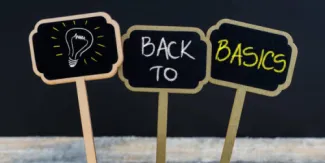
Back to the Investment Basics Part 5 of 5: Patience and Personal Persistence
So far, in our investment basics series, we’ve explored the history of investing; how important it is to save (so you have money to invest); how to invest efficiently in broad markets; and why to avoid chasing or fleeing rising or falling prices.
By applying these principles, you are much better positioned to let capital markets work their wonders on your investments. But there are two more essentials that can make or break even the most sensible portfolio, and neither of them are about market dynamics. They’re about you.
Once you’ve structured your investments to capture available, risk-adjusted market returns, you’ll need to stay on track as planned.
This calls for channeling your ability to be patient and ensuring that your personal goals—rather than shifting market conditions—drive your ongoing decisions.
1. You can’t invest if you haven’t saved.
2. Markets are inspired by ingenuity and tempered by diversification.
3. The price you pay matters.
4. Patience is a virtue.
5. Investing is personal.
Investing Like a 90-Year-Old
As we touched on earlier in this series, it’s risky to fixate on the most recent, random bursts of market activity. If you view the market close-up, you’re likely to perceive false or at least misleading “patterns” that instill worrisome or bold outlooks, even though all evidence suggests we cannot know what to expect next.
This, in turn, can trick you into making impatient investment choices that neither reflect nor advance your personal financial goals.
Instead, we suggest taking a wider view of the market across years of performance. This typically reveals a smoother upward progression—even if it rarely feels smooth at the time! Of course, we still can’t chart the future with certainty. Still, we can at least envision a range of potential dotted lines, generally pointing onward and upward … if you remain patient and participatory in the market’s expected growth.
As 92-year-old Warren Buffett observed:
“Our stay-put behavior reflects our view that the stock market serves as a relocation center at which money is moved from the active to the patient.”
— 1991 Berkshire Hathaway Shareholders Letter
Buffett wrote this statement more than 30 years ago and was practicing it long before then. He hasn’t changed his tune either, as evidenced in this more recent reflection:
“Productive assets such as farms, real estate and, yes, business ownership produce wealth – lots of it. … All that’s required is the passage of time, an inner calm, ample diversification and a minimization of transactions and fees.”
— 2020 Berkshire Hathaway Shareholders Letter
Being patient and preferring decades-long investment commitments has worked wonders for Buffett. You could do worse than to emulate someone who has been investing for 70-some years and has long been among the wealthiest people on the planet.
Investing Isn’t Always the Answer
However, before you invest everything you own, there’s a related caveat: Not all your money belongs in the market.
First, even the most unemotional investor’s patience can wear thin during periodic, occasionally lengthy downturns. Diversification, along with more stable investments, can help you maintain your resolve during troubling times.
Beyond that, keeping some cash or cash-like assets on hand throughout your life is critical to funding near-term spending needs. The goal is to avoid a scenario where you have critical upcoming expenses, but the only way to cover them is to sell investments that have just taken a beating in the market or are otherwise tied up in holdings that can’t readily be converted to cash.
That said, holding too much cash comes with its own risks. Most notably, cash rarely keeps pace with inflation, so you’re likely to lose spending power over time.
The trick is to balance investing toward future spending and keeping enough cash to cover upcoming expenses. For example, if your child is heading to college in the next year or two, you probably don’t want to wager their entire tuition bill on whether the market remains stable until then. On the other hand, if your child is still a toddler, you’ve got years to let that money earn market returns over time.
This brings us to our final point.
Investing Is Personal
How do you decide how much to invest and keep in reserve for upcoming expenses (such as buying a home, paying for higher education, paying down debt, etc.)?
The answer is personal. The market is like an ocean: endless, ever changing, and enduring. Since there’s no way you can control this greater force, how you choose to navigate it should be focused on your particulars. Not your neighbor’s interests, nor what the popular financial press would have you think.
As you harness our previous investment essentials to build and manage your evidence-based investment portfolio, each decision you make should be grounded in your personal financial goals, when you want or need to achieve them, and which risk/reward tradeoffs you are willing or unwilling to make along the way.
To help you focus accordingly, we recommend forming a solid plan (which we can help with) and then automating as many of your investment decisions as possible. The fewer decisions you must make or re-make, the less indecision will wear away at your resolve over time. This advice is timeless and will serve you well.
In other words, your investments should remain personal, guided by your own wants and needs. Then, let the companies, products, and services they offer that make up the market do their long-term thing.
By following these essentials, you can spend less time deciding what to do next and more time doing it. That’s a good idea for any age and a great way to wrap up our multi-part series on investment basics.
We’d love to continue the conversation with you in person. Reach out to us to schedule some time to talk.
Untill next time, happy planning!
Cort

